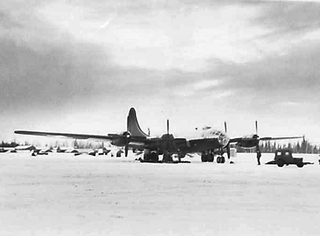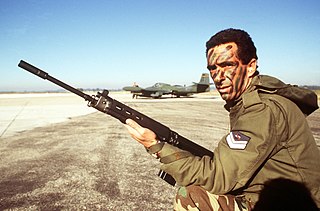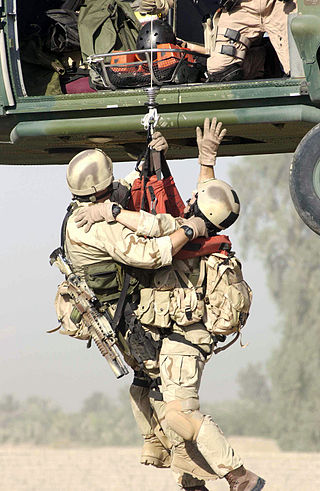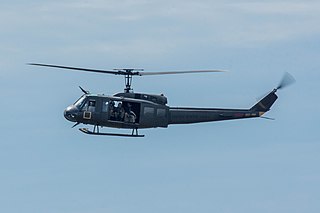
The 353rd Special Operations Wing is an operational unit of the United States Air Force Special Operations Command, stationed at Kadena Air Base, Japan.

The 29th Flying Training Wing is an inactive United States Air Force unit last based at Craig Air Force Base, Alabama. It was inactivated when Craig was closed when the Air Force reduced its pilot training program after the Vietnam War.

The 414th Fighter Group is an Air Reserve Component (ARC) of the United States Air Force. It is assigned to the 944th Fighter Wing of Tenth Air Force, Air Force Reserve Command, stationed at Seymour Johnson Air Force Base, North Carolina.

The 1st Fighter Squadron is an inactive unit of the United States Air Force. It was most recently based at Tyndall Air Force Base, Florida, where it operated McDonnell Douglas F-15C Eagle aircraft conducting advanced fighter training.

The 512th Rescue Squadron is part of the 58th Special Operations Wing based at Kirtland Air Force Base, New Mexico. It formerly operated the Bell UH-1N Twin Huey and currently operates the Sikorsky HH-60G Pave Hawk and the new HH-60W Jolly Green II helicopters training aircrew conducting search and rescue missions.

The 311th Air Division is an inactive United States Air Force organization. Its last assignment was with Strategic Air Command at Barksdale Air Force Base, Louisiana, where it was inactivated on 1 November 1949. The division was first activated in 1944 as the 311th Photographic Wing. Although it was stationed in the United States, throughout its existence, the unit was responsible for the control of long range reconnaissance units in multiple theaters.

The 310th Air Division is an inactive United States Air Force organization. Its last assignment was with Continental Air Command's Twelfth Air Force at Tinker Air Force Base, Oklahoma, where it was inactivated on 27 June 1949.

The 563rd Rescue Group is a United States Air Force unit stationed at Davis-Monthan Air Force Base, Arizona. The group also controls the rescue squadrons at Nellis Air Force Base, Nevada. It is assigned to the 355th Wing. The group directs flying operations dedicated to personnel recovery and is part of Air Combat Command. The group was activated under its current designation at Davis-Monthan in 2003 to command rescue units in the western United States.

The VII Bomber Command is an inactive United States Air Force unit. Its last assignment was with Seventh Air Force, based on Okinawa. It was inactivated on 31 March 1946.

The 53rd Test and Evaluation Group is a group of the United States Air Force. It is a part of the 53rd Wing, and is headquartered at Nellis AFB, Nevada.

I Fighter Command was a United States Army Air Forces intermediate command responsible for command and control of the fighter operations within the First Air Force during World War II. It was initially established in June 1941 as the 1st Interceptor Command to provide air defense of the Northeastern United States. Following the attack on Pearl Harbor, the command's area of responsibility extended over the entire Atlantic coast and into Canada and Iceland. As the perceived threat of attack decreased, the command's responsibnility for training units and aircrews became its primary mission. The command continued its mission until March 1946, when it was inactivated.

The 566th Air Defense Group is a disbanded unit of the United States Air Force. Its last assignment was with the 28th Air Division at Hamilton Air Force Base, California, where it was inactivated on 18 August 1955. The group was originally activated as the 566th Air Service Group, a support unit for a combat group at the end of World War II but never deployed before it was inactivated in 1945.

The 90th Operations Group is the operational component of the 90th Missile Wing of the United States Air Force. It is stationed at Francis E. Warren Air Force Base, Wyoming, and is assigned to Twentieth Air Force of Air Force Global Strike Command. The group is responsible for maintaining and operating on alert the wing's assigned LGM-30G Minuteman III intercontinental ballistic missiles.

The 920th Air Refueling Squadron is an inactive United States Air Force unit. It was last assigned to the 379th Bombardment Wing at Wurtsmith Air Force Base, Michigan where it was inactivated on 30 September 1992.

The 917th Air Refueling Squadron is an inactive United States Air Force unit. It was last active as a Geographically Separated Unit at Dyess Air Force Base, Texas, while assigned to the 43d Operations Group at Malmstrom Air Force Base, Montana, where it was inactivated on 1 July 1994.

The 32d Air Expeditionary Group is a provisional unit of the United States Air Force (USAF). It is assigned to United States Air Forces in Europe (USAFE) to activate or inactivate at any time. It was last active as the 32d Air And Space Operations Center in December 2006 at Ramstein Air Base, Germany.

The 24th Tactical Air Support Squadron was a ground attack squadron of the United States Air Force. It was last active at Nellis Air Force Base in Nevada, prior to being inactivated during December 2020.

The 1st Expeditionary Rescue Group is a provisional unit of the United States Air Force assigned to Air Combat Command to activate or inactivate as necessary. It was activated in Southwest Asia in September 2015 to provide combat search and rescue for Operation Inherent Resolve.

The 320th Special Tactics Squadron is a Special Tactics unit of the United States Air Force Special Operations Command, based at Kadena Air Base.

The 72nd Helicopter Squadron is an inactive United States Air Force unit. It was last active as a flight, then as a squadron from 1991 to 1995 at Langley Air Force Base, Virginia, where it provided light transport and assisted with search and rescue operations.





























